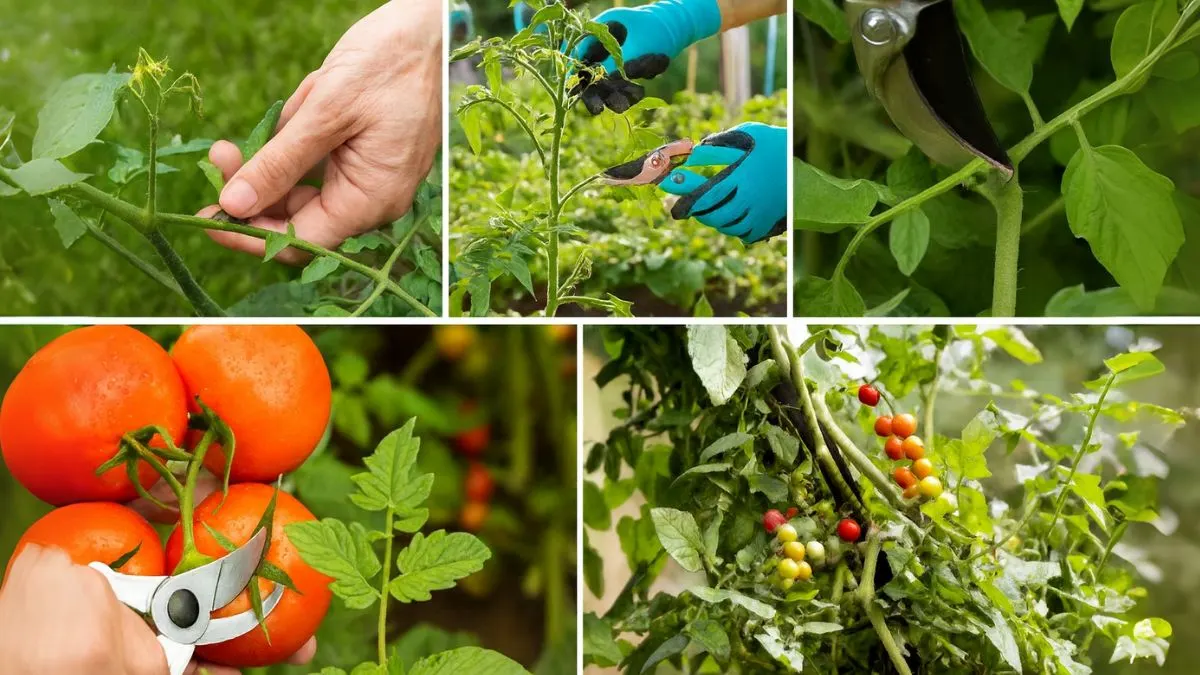If you’ve ever wondered why your neighbor’s tomato plants look stronger, healthier, and produce more fruit, the secret might be pruning. Proper pruning is a game-changer for tomato growers. It keeps plants tidy, improves airflow, prevents disease, and channels energy into producing bigger and tastier tomatoes.
For beginners, it may sound intimidating, but once you understand the basics, you’ll see how simple and effective it really is. This guide will show you exactly how to prune tomato plants correctly for bigger harvests without overwhelming you.
Why Pruning Matters

Tomato plants naturally want to grow wild and bushy. Left on their own, they’ll send out multiple side shoots, branches, and leaves. While that looks lush, it often results in fewer, smaller fruits.
Here’s why pruning works:
- It improves sunlight exposure.
- It reduces the chances of fungal diseases.
- It directs energy toward fruit instead of excess foliage.
- It helps you harvest more easily.
Simply put, pruning tomatoes can create stronger and healthier plants.
Step 1: Know Your Variety
Before you pick up the scissors, remember this golden rule: you should only prune indeterminate varieties.
- Indeterminate tomatoes (like heirlooms, cherry, or beefsteak) keep growing and producing fruit all season. They benefit most from regular pruning.
- Determinate tomatoes (often labeled as bush varieties) have a set size and yield. Pruning them too much can actually reduce harvest.
So, always check your seed packet or plant label before you begin.
Also Read: How Much Water Does Mint Really Need?
Step 2: Spot and Remove Suckers
The most important part of tomato pruning is learning to recognize suckers. These are small shoots that grow at the joint where a branch meets the main stem. To maximize fruit production, you need to identify and pinch off “suckers” (side shoots) that grow between the main stem and a branch.
For best results, prune off suckers when they are 3 inches (8 cm) or less. At this size, you can easily pinch them with your fingers. If they’re larger, use clean, sharp pruners to avoid damaging the plant.
By controlling suckers early, you prevent your plant from becoming overcrowded while still leaving enough foliage for photosynthesis.
Step 3: Focus on Lower Branches
One of the most common mistakes beginners make is ignoring the base of the plant. Always trim all the lower branches, especially as your tomato grows taller.
Why? Leaves that are close to the soil are more prone to splashing water, which carries diseases. That’s why you should focus on removing lower branches that touch the ground. Not only does this prevent problems like blight, but it also improves airflow and makes watering easier.
Step 4: Timing Matters
Pruning is not just about what you remove, but also when you remove it. The right timing ensures you don’t stress your plant unnecessarily.
The best practice is to prune these larger stems when it is dry outside and not during the midday heat.
- Dry weather helps prevent disease from entering fresh cuts.
- Cooler morning or evening hours reduce plant stress.
Avoid heavy pruning when your plant is flowering heavily or when temperatures are at their peak.
Also Read: 5 Unique Edible Leaf Plants to Add to Your Home Garden
Step 5: Maintain a Balance
The goal of pruning is not to strip your plant bare but to create balance. Too much foliage removal can expose fruits to sunscald, while too little can lead to overcrowding.
Aim to:
- Keep one or two strong central stems.
- Remove suckers regularly.
- Maintain a healthy canopy of leaves for shade and photosynthesis.
This balance leads to a strong plant with enough energy to produce a steady stream of tomatoes all season long.
Personal Experience
When I first started growing tomatoes on my balcony, I ignored pruning because I thought “more leaves = more fruit.” I ended up with a jungle of vines, plenty of green foliage, but only a handful of small tomatoes.
The next year, I followed the simple rule to prune off suckers when they are 3 inches (8 cm) or less and trim all the lower branches. The difference was unbelievable—I harvested nearly three times as many tomatoes, and they were larger, juicier, and ripened evenly. That’s when I realized pruning isn’t optional—it’s essential.
Quick Pruning Guide
Step |
Action |
Why It Matters |
1 |
Identify and pinch off “suckers” (side shoots) that grow between the main stem and a branch |
Prevents overcrowding and directs energy to fruit |
2 |
Prune off suckers when they are 3 inches (8 cm) or less |
Easier removal and less stress on plant |
3 |
Trim all the lower branches |
Stops disease from spreading from soil |
4 |
Focus on removing lower branches that touch the ground |
Increases airflow and reduces rot |
5 |
Prune these larger stems when it is dry outside and not during the midday heat |
Prevents infection and stress |
6 |
You should only prune indeterminate varieties |
Ensures bush tomatoes aren’t harmed |
Also Read: From Poinsettias to Holly: Gorgeous Christmas Plants for Your Home
Pruning might feel intimidating at first, but once you understand the process, it becomes second nature. The key steps are to remove suckers early, clean up lower branches, and time your pruning sessions carefully.
Remember: pruning tomatoes can create stronger and healthier plants. By following these steps, you’ll enjoy bigger, more consistent harvests throughout the season.
So next time you’re in the garden, don’t just water and walk away. Take a moment to check for suckers, trim lower branches, and give your tomato plants the care they deserve. Your future harvest will thank you!






